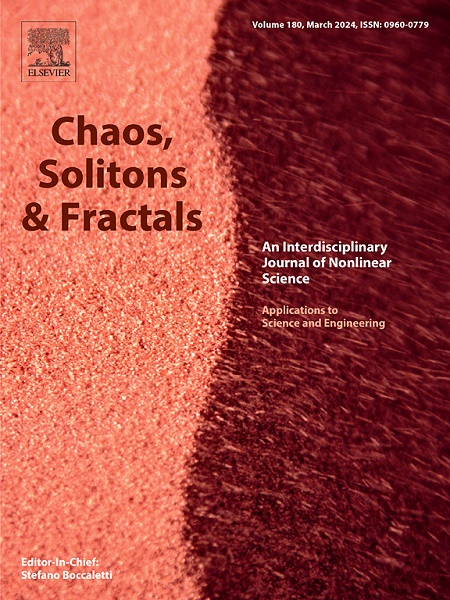类kerr原色等边受限四体问题的动力学研究
IF 5.6
1区 数学
Q1 MATHEMATICS, INTERDISCIPLINARY APPLICATIONS
引用次数: 0
摘要
用数值方法研究了一类类kerr原色的受限四体问题的动力学行为。通过计算有效势的Hessian矩阵的正特征值的个数,分析了平衡点的位置和线性稳定性,并进一步将其划分为指标i和指标ii鞍点。结果表明,超过旋转参数的临界值,平衡点就失去了线性稳定性。此外,我们还对相空间轨迹进行了系统和详细的分类。基于全面的数值分析,将初始条件分为三种主要类型:(i)有界规则轨道,(ii)逃逸轨道和(iii)碰撞轨道。每个初始条件都根据其轨道结果进行颜色编码,生成称为轨道类型图(OTDs)的可视化表示。结果揭示了系统动力学行为的高度复杂性。特别地,逃逸盆地的结构表现出强烈的依赖于总轨道能量。分形盆地边界在所有的逸出体系中都可以观察到,这表明系统的能量水平和逸出通道的几何形状之间存在复杂的相互作用。本文章由计算机程序翻译,如有差异,请以英文原文为准。
On the dynamics of the equilateral restricted four-body problem with Kerr-like primaries
The dynamical behavior of the restricted four-body problem with Kerr-like primaries is investigated numerically. We analyze the positions and linear stability of the equilibrium points and further classify them into index-I and index-II saddle points by evaluating the number of positive eigenvalues of the Hessian matrix of the effective potential. Our results show that the equilibrium points lose linear stability beyond a critical value of the rotation parameter. In addition, we perform a systematic and detailed classification of phase space trajectories. The initial conditions are categorized into three main types: (i) bounded regular orbits, (ii) escaping orbits, and (iii) collision orbits, based on a thorough numerical analysis. Each initial condition is color-coded according to its orbital outcome, yielding visual representations referred to as orbit type diagrams (OTDs). The results reveal a high degree of complexity in the system’s dynamical behavior. In particular, the structure of the escape basins exhibits a strong dependence on the total orbital energy. Fractal basin boundaries are observed across all escape regimes, indicating a complex interplay between the system’s energy levels and the geometry of the escape channels.
求助全文
通过发布文献求助,成功后即可免费获取论文全文。
去求助
来源期刊

Chaos Solitons & Fractals
物理-数学跨学科应用
CiteScore
13.20
自引率
10.30%
发文量
1087
审稿时长
9 months
期刊介绍:
Chaos, Solitons & Fractals strives to establish itself as a premier journal in the interdisciplinary realm of Nonlinear Science, Non-equilibrium, and Complex Phenomena. It welcomes submissions covering a broad spectrum of topics within this field, including dynamics, non-equilibrium processes in physics, chemistry, and geophysics, complex matter and networks, mathematical models, computational biology, applications to quantum and mesoscopic phenomena, fluctuations and random processes, self-organization, and social phenomena.
 求助内容:
求助内容: 应助结果提醒方式:
应助结果提醒方式:


